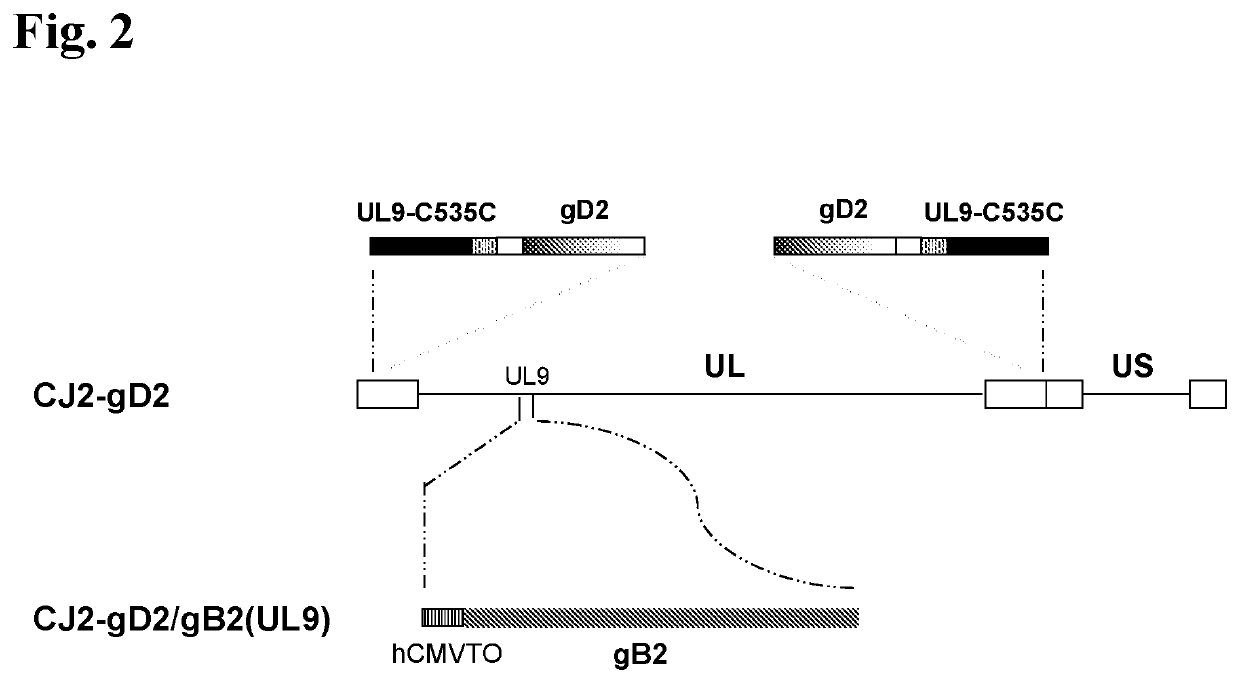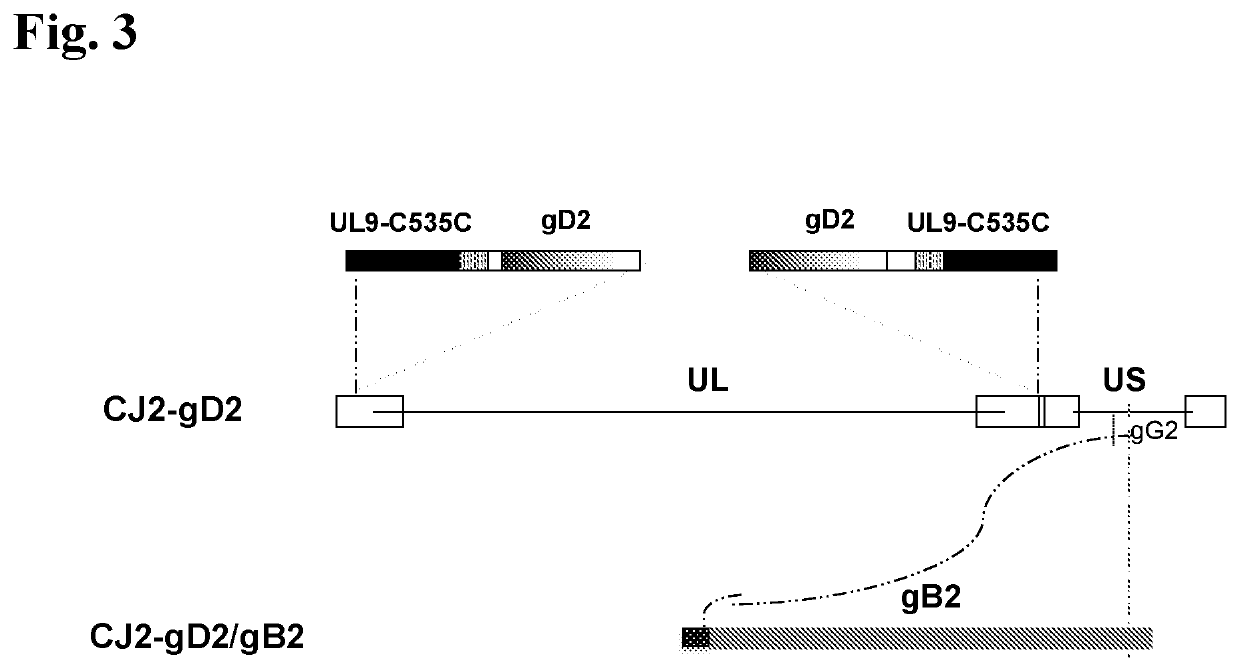Recombinant Herpes Simplex Virus-2 expressing glycoprotein B and D antigens
- Summary
- Abstract
- Description
- Claims
- Application Information
AI Technical Summary
Benefits of technology
Problems solved by technology
Method used
Image
Examples
example 1
[0219]Construction and Characterization of CJ2-gD2 / gB2(UL9) and CJ2-gD2 / gB2, and Testing the Vaccine Efficacy of CJ2-gD2 / gB2.
[0220]The current example describes 1) the construction and in vitro characterization of a CJ2-gD2-derived recombinant virus, CJ2-gD2 / gB2(UL9), in which the gB2 gene is inserted at a site encoding a gene needed for viral replication (the UL9 gene) and is operably linked to a tetO-bearing hCMV immediate-early promoter (see FIG. 2), and 2) the construction and in vitro characterization of a CJ2-gD2-derived recombinant virus, CJ2-gD2 / gB2, in which the codon-optimized gB2 gene is inserted at a site encoding HSV-2 glycoprotein G (gG2) and is operably linked to a tetO-bearing HSV-1 ICP0 promoter (see FIG. 3).
[0221]Materials and Methods
[0222]Cells: African Green Monkey Kidney (Vero) cells and the human osteosarcoma line U2OS cells were grown and maintained in Dulbecco's Modified Eagle's Medium (DMEM; Sigma Aldrich) supplemented with 10% fetal bovine serum (FBS) in th...
example 2
[0262]Evaluation of CJ2-gD2 / gB2 as a Therapeutic Vaccine Against HSV-2 Genital Herpes in Guinea Pigs
[0263]Experimental Design
[0264]Twenty-eight female Hartley guinea pigs were intravaginally infected with 5×105 PFU of HSV-2 strain MS / wp28 on day 0 as previously described (Zhang, et al., PLOS ONE, 9:e101373 (2014)). On day 21 post-intravaginal infection, the surviving animals (27 of 28) were divided into 2 groups based on the disease scores as well as titers of virus shedding on days 2 and 5. Animals in group 1 (n=13) were sham-immunized with DMEM, while animals in group 2 (n=14) were immunized with CJ2-gD2 / gB2 at a dose of 5×106 PFU / animal in 50 μl. Animals were boosted with DMEM or CJ2-gD2 / gB2 two weeks later. All animals were examined for clinical scores daily until day 70 post-challenge. The number of lesions for individual animals was counted and the disease was scored non-blindly as previously described: 0=no disease; I=redness or swelling; 2=a few small vesicles; 3=several lar...
example 3
[0286]Evaluation of Purified CJ2-gD2 / gB2 Virus as a Prophylactic Vaccine Against HSV-2 Genital Herpes Infection in Mice
[0287]Materials and Methods
[0288]Virus purification. Purification of CJ2-gD2 and CJ2-gD2 / gB2 viruses can be done using a chromatography-based purification as described in Mundle, S. T., et al. PLOS One. February 2013; 8(2):e57224, which is incorporated herein in its entirety. This purification requires a viral harvest method that utilizes a chemical treatment of infected cells by the sulfated polymeric anion dextran sulfate (DS) to elute the virus from the surface of the cells. The purification procedure led to a >3 log and >5 log reduction of host cell protein and host cell DNA, respectively, in the CJ2-gD2 / gB2 virus batch.
[0289]Animal experiments in mice. Female Balb / cAnNCrl mice were purchased from Charles River Laboratories (Sulzfeld, Germany) and kept at the AAALAC-certified institutional animal facility under specified pathogen-free conditions. Animals were co...
PUM
| Property | Measurement | Unit |
|---|---|---|
| Composition | aaaaa | aaaaa |
Abstract
Description
Claims
Application Information
 Login to View More
Login to View More - R&D
- Intellectual Property
- Life Sciences
- Materials
- Tech Scout
- Unparalleled Data Quality
- Higher Quality Content
- 60% Fewer Hallucinations
Browse by: Latest US Patents, China's latest patents, Technical Efficacy Thesaurus, Application Domain, Technology Topic, Popular Technical Reports.
© 2025 PatSnap. All rights reserved.Legal|Privacy policy|Modern Slavery Act Transparency Statement|Sitemap|About US| Contact US: help@patsnap.com



